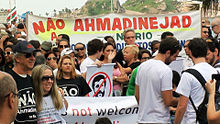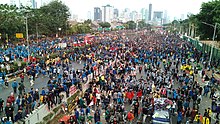
Back احتجاج Arabic Protesta AST Etiraz Azerbaijani Протест Bulgarian Protesta Catalan Protest Czech Protest Welsh Protest German Protesto Esperanto Protest Estonian
This article has multiple issues. Please help improve it or discuss these issues on the talk page. (Learn how and when to remove these template messages)
|


| Part of a series on |
| Political revolution |
|---|
 |
|
|
A protest (also called a demonstration, remonstration, or remonstrance) is a public expression of objection, disapproval, or dissent towards an idea or action, typically a political one.[1][2] Protests can be thought of as acts of cooperation in which numerous people cooperate by attending, and share the potential costs and risks of doing so.[3] Protests can take many different forms, from individual statements to mass political demonstrations. Protesters may organize a protest as a way of publicly making their opinions heard in an attempt to influence public opinion or government policy, or they may undertake direct action in an attempt to enact desired changes themselves.[4] When protests are part of a systematic and peaceful nonviolent campaign to achieve a particular objective, and involve the use of pressure as well as persuasion, they go beyond mere protest and may be better described as civil resistance or nonviolent resistance.[5]
Various forms of self-expression and protest are sometimes restricted by governmental policy (such as the requirement of protest permits),[6] economic circumstances, religious orthodoxy, social structures, or media monopoly. One state reaction to protests is the use of riot police. Observers have noted an increased militarization of protest policing in many countries, with police deploying armored vehicles and snipers against protesters. When such restrictions occur, protests may assume the form of open civil disobedience, more subtle forms of resistance against the restrictions, or may spill over into other areas such as culture and emigration.
A protest itself may at times be the subject of a counter-protest. In such cases, counter-protesters demonstrate their support for the person, policy, action, etc. that is the subject of the original protest. Protesters and counter-protesters can sometimes violently clash. One study found that nonviolent activism during the civil rights movement in the United States tended to produce favorable media coverage and changes in public opinion focusing on the issues organizers were raising, but violent protests tended to generate unfavorable media coverage that generated public desire to restore law and order.[7]
- ^ "Definition of PROTEST". www.merriam-webster.com. Retrieved 4 March 2020.
- ^ "PROTEST (noun) definition and synonyms | Macmillan Dictionary". www.macmillandictionary.com. Retrieved 4 March 2020.
- ^ Larson, Jennifer M. (11 May 2021). "Networks of Conflict and Cooperation". Annual Review of Political Science. 24 (1): 89–107. doi:10.1146/annurev-polisci-041719-102523.
- ^ St. John Barned-Smith, "How We Rage: This Is Not Your Parents' Protest," Current (Winter 2007): 17–25.
- ^ Roberts, Adam (2009). Ash, Timothy Garton (ed.). Civil Resistance and Power Politics: The Experience of Non-violent Action from Gandhi to the Present. Oxford University Press. pp. 2–3. ISBN 978-0-19-955201-6.
- ^ Daniel L. Schofield, S.J.D. (November 1994). "Controlling Public Protest: First Amendment Implications". in the FBI's Law Enforcement Bulletin. Retrieved 16 December 2009.
- ^ Omar Wasow. "Agenda Seeding: How 1960s Black Protests Moved Elites, Public Opinion and Voting" (PDF). Retrieved 12 January 2021.
© MMXXIII Rich X Search. We shall prevail. All rights reserved. Rich X Search